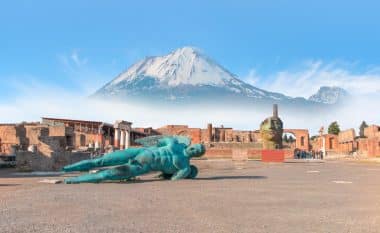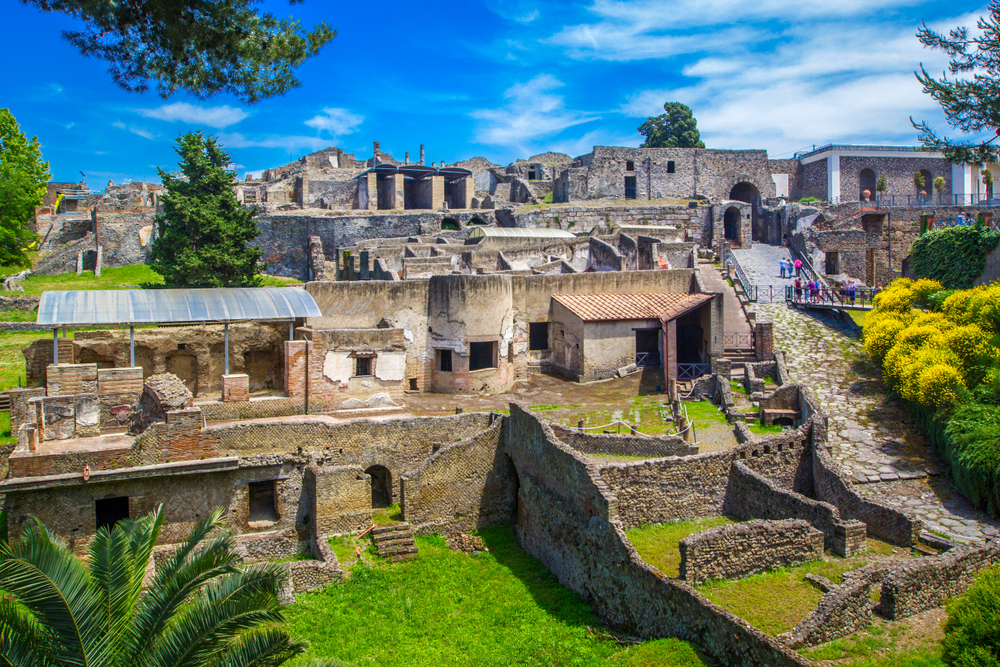If you are traveling in the Naples region in the south of Italy, you simply can’t get past the small town. This is characterized by the famous archaeological sites of Pompeii, Herculaneum and Torre Annunziata. The remains of the ancient Roman city at the foot of Mount Vesuvius, which was covered by a layer of ash and stone several meters thick when the volcano erupted on August 24, 79 AD, are among the most famous sights in Italy and captivate many millions of locals and tourists from all over the world every year.
Due to its popularity, you have to be prepared for long waiting times when visiting Pompeii. Since the end of the 1990s, the archaeological sites have been a UNESCO World Heritage Site. You can explore the excavation sites either on your own with an audio guide or as part of a guided tour. Here you will learn a lot of exciting details about life in Pompeii and the end of the former Roman small town. Due to the size of the entire area and the numerous highlights, you should plan a lot of time for visiting the excavation sites. Since the extensive area can only be visited on foot, sturdy shoes should be worn and sufficient drinks should be brought along.
Exciting insights into real ancient life

In the 16th century, the excavations of Pompeii began. In the past centuries, large parts of the city in and around Pompeii were gradually excavated again at great expense and made accessible to visitors. Numerous streets, houses, small and large statues or pictures are still very well preserved. Many famous mosaics and frescoes from antiquity are also still very well preserved. In Pompeii, you get an extremely exciting insight into Roman life more than 2000 years ago.
Among the most spectacular buildings on the entire site are the Temple of Apollo and the large Forum, which served as a marketplace and center of all public life in Pompeii for a long time. The well-preserved large amphitheater for up to 20000 people should not be missed. The numerous small shops, bars and taverns in the large main street Via dell’Abbondanza also give an extremely exciting insight into daily life in Roman antiquity. To make your visit to Pompeii a pleasant and unforgettable experience, there are numerous small and large accommodations for all tastes throughout the region. From here you can easily start the excursion to Pompeii. If possible, a visit to the excavation sites should also be combined with a trip to Vesuvius. The volcano should not be missed.
The small town of Pompeii, which today has about 25,000 inhabitants, is also always worth an extra visit. The most famous sight of the city is the impressive pilgrimage church of the Rosary. From its bell tower you have a sensational view over the entire region with the huge excavation sites to the idyllically situated Gulf of Naples. About 16 kilometers from Pompeii, the small town of Amalfi is located directly on the west coast of the Gulf of Salerno. On the Amalfi Coast, which is known far beyond Italy’s borders, lies Strada Statale 163 Amalfitana, one of the most beautiful coastal roads in Europe.
Best time to visit Pompeii: June to August
The best time to travel to Pompeii is during the summer months from June to August. During these months, pleasantly warm temperatures of about 30 degrees Celsius and plenty of sunshine are to be expected. Precipitation is very rare during this time. But if you want to avoid the large number of tourists during this time or if the summer temperatures are simply too warm for you, you should rather go to Pompeii in spring or autumn. Especially in autumn, there are still pleasant temperatures between 20 and 25 degrees Celsius. However, some rain showers are to be expected again and again during this time. The archaeological sites of Pompeii can be reached via Piazza Esedra, which is located a few meters from the Pompei Villa dei Misteri train station, or Piazza Anfitetro, near the Pompei Santuario train station. If you arrive by car, you can reach the excavation sites, which are only closed three days a year (on 1 January, 1 March and 25 December), via the A3 motorway.


